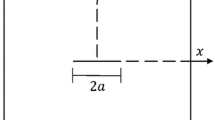Abstract
The single stress function approach of Westergaard has been effective for a certain class of stress-prescribed crack problems. In the present study, the Westergaard approach was successfully extended to displacement-prescribed crack problems. The method presented, which requires no more than the evaluation of integrals, significantly simplifies the analysis. The method is easily extended to crack problems involving displacement-prescribed and stress-prescribed conditions. This initial study laid the ground work for the subsequent extension to the mixed problem.
Similar content being viewed by others
References
H.M. Westergaard, Transactions ASME, Journal of Applied Mechanics A66 (1939) 44–53.
H. Tada, P.C. Paris and G.R. Irwin, The Stress Analysis of Cracks Handbook, Del Research Corporation, St. Louis, Missouri (1985).
G.I. Barenblatt, in Advances in Applied Mechanics, Vol. VII, Academic Press, New York (1962) 55–129.
I.N. Sneddon, The Distribution of Surface Stress Necessary to Produce a Griffith Crack of Prescribed Shape', in two lectures concerning pressurized cracks, North Carolina State University, Department of Mathematics Report, Raleigh (1969)
J. Tweed, The Stress Intensity Factor of a Griffith Crack Which is Opened by a Thin Symmetric Wedge, North Carolina State University, Department of Mathematics Report, Raleigh (1970).
A.E.H. Love, A Treatise on the Mathematical Theory of Elasticity, Dover, New York (1944).
A.H. Cottrell, Dislocations and Plastic Flow in Crystals, Oxford (Clarendon) Press, Oxford (1953).
B.A. Bilby and J.D. Eshelby, in Fracture, Vol. I, H. Liebowitz (ed.), Academic Press, New York (1968) 99–182.
N.I. Muskhelishvili, Some Basic Problems of the Mathematical Theory of Elasticity, 4th edn., Noordhoff, Groningen, Netherlands (1963).
G. Sih, International Journal of Fracture Mechanics 2 (1966) 628–631.
J. Eftis and H. Liebowitz, International Journal of Fracture 8 No. 4 (1972) 383–392.
J. Eftis, X. Subramonian and H. Liebowitz, Engineering Fracture Mechanics 9 (1977) 189.
H. Okamura, Introduction to Linear Elastic Fracture Mechanics, a Fracture Mechanics and Materials' Strength Series, H. Kihara (ed.), Baifu-Kan, Tokyo (1976) (in Japanese).
J. Eftis, Engineering Fracture Mechanics 26, No. 4 (1987).
R.J. Sanford, Mechanics Research Communication 6(5) (1979) 289–294.
D. Hull and D.J. Bacon, Introduction to Dislocations, Pergamon Press (1984).
I.S. Gradshteyn and I.M. Ryzhik, Table of Integrals, Series and Products, Academic Press, Inc (1980).
Author information
Authors and Affiliations
About this article
Cite this article
Tada, H., Ernst, H.A. & Paris, P.C. Westergaard stress functions for displacement-prescribed crack problems—I. Int J Fract 61, 39–53 (1993). https://doi.org/10.1007/BF00032338
Received:
Accepted:
Issue Date:
DOI: https://doi.org/10.1007/BF00032338




